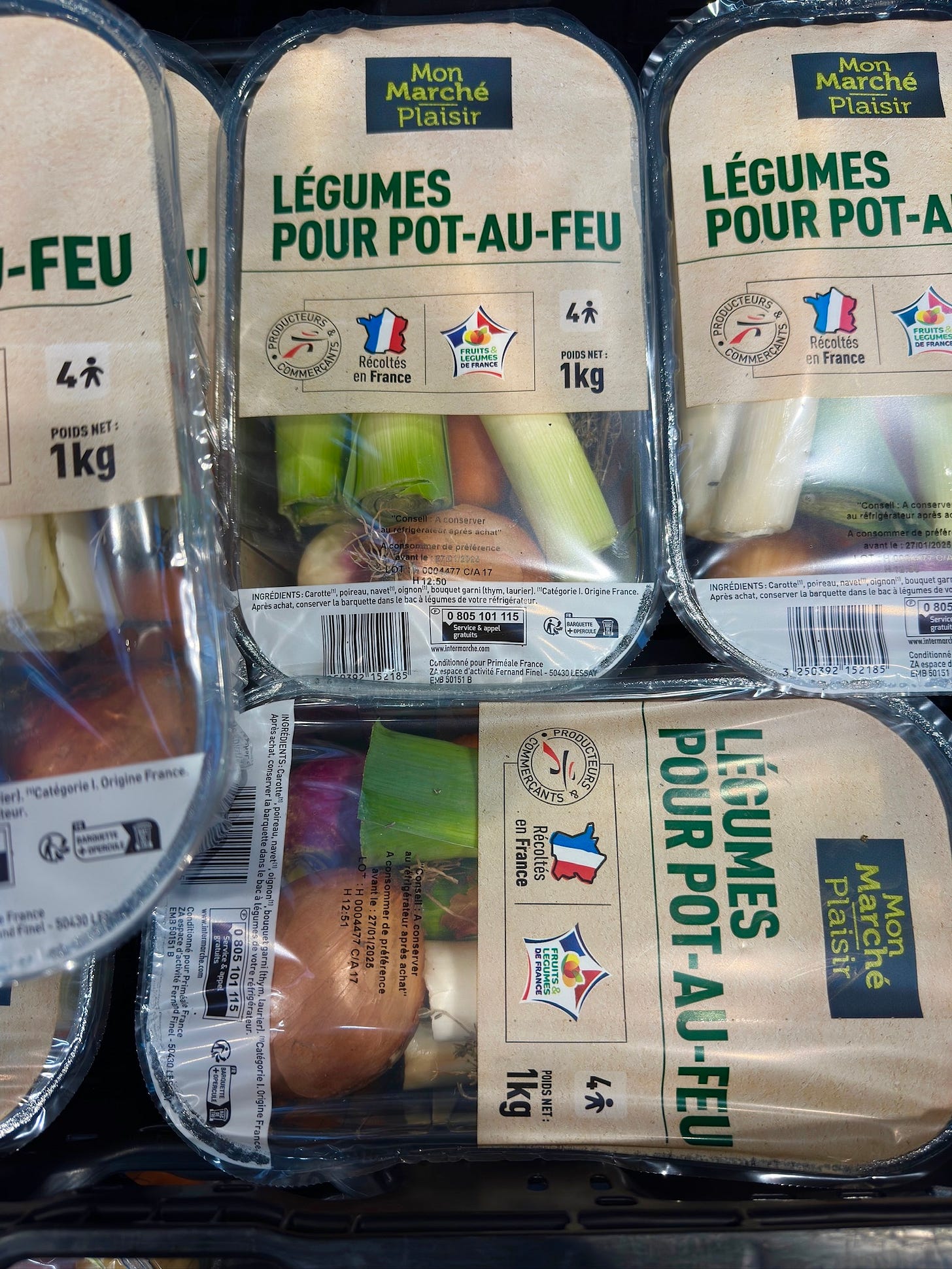Hi Everyone,
Just back from Europe where we celebrated the engagement of our eldest daughter, Olivia. We spent time in the Paris region, visited my mother-in-law, Marie-Louise, and enjoyed a few days in St. Anton, a lovely Tyrolean Alpine village in Austria. I’ve been cooking with Marie-Louise and filming as we go to archive some of her favorite recipes. If you go to my Instagram (@chouquettekitchen) you can see her in action. Her pot-au-feu recipe was much-requested so I’ve written it below and also added my version. This week I’m also telling you a little about croissant-speak in France. Please read on!
1. Marie-Louise's Pot-au-Feu
I promised I’d take a deep dive into all things pot-au-feu (the translation is “pot on the fire”) which is the national dish of France. Marie-Louise’s recipe is below with the cuts of meat she buys at the butcher. She insists on using several cuts of beef for the flavor they impart to the bouillon and this is indeed the traditional method for pot-au-feu. The oxtails, once cooked, have very little meat on them and she does not serve them, however the bones add delicious flavor to the broth. The veal marrow bones are added to the bouillon about 30 minutes prior to serving. Longer than that and the marrow would melt into the bouillon and the bones would be empty. Additionally, all these cuts are pretty lean, so she doesn't find it necessary to skim the fat from the top of the bouillon prior to serving. Any leftover meat is used to make hachis parmentier the next day.
Marie-Louise starts her pot-au-feu by filling the “marmite” (large pot) with cold water, then adding the meats in, which produces a clearer bouillon in the end. Skimming is an essential step in making pot-au-feu so don’t skip it.
Equipment Needed
Recipe
Gite - from the hind end of the cow, eye of round, bottom round, (rump roast) or top round 1.4 kilos (about 3 lbs)
Macreuse (or paleron) - cut from the shoulder, chuck or brisket 500g (about 1 lb)
Joue - beef cheek 250g (about ½ lb)
Queue de Boeuf - Oxtail 250g (about ½ lb)
Os à Moelle de Veau - veal marrow bones 250g (about 1/2 lb)
1 bay leaf
2 sprigs of thyme
2-3 parsley sprigs
1 sprig of rosemary
6 whole black peppercorns
Kosher salt
1 yellow onion, peeled, studded with 4 whole cloves
4 carrots, peeled
2 ribs of celery
3 turnips, peeled and halved
½ a head of savoy cabbage, cored, trimmed, and halve the half
3-4 leeks, white and light green parts, cleaned, left whole but partially split down the middle for thorough cleaning
½ t piment d’Espelette*
6 medium Yukon gold potatoes, peeled, halved if large
Chopped parsley for garnish
Tie herbs into a little bundle using kitchen twine, or tie them into a piece of cheesecloth. Set aside. Tie the leeks together in a bundle, for easy extraction from the pot once they are cooked.
Fill a large Dutch oven or lidded pot halfway with cold water. Add the beef, the clove-studded onion, peppercorns, and a tablespoon of salt. Add more water if necessary to just cover the meat. Cover the pot and bring to a boil, then lower the heat to a vigorous simmer. Once the stew has simmered for 10 minutes, uncover the pot and skim the foam that collects at the top. Cover the pot again. Repeat skimming once more over a 20 minute period. Skimming ensures a clear bouillon.
After 20 minutes, add the herb bundle, all vegetables except the potatoes, the piment d’Espelette, if using, and cover the pot. Bring to a boil, then reduce heat to a simmer and cook for about 2½ hours. Add in the marrow bones, if using, cover the pot and continue to cook for 30-45 minutes. Check beef for tenderness: if it’s not fork tender, continue to cook and check again in 15 minute increments.
Steam potatoes separately in a pressure cooker or steamer. Remove the herb bundle, onion, and celery ribs. Taste broth for salt and pepper. Use a slotted spoon to remove vegetables and beef from the pot and place on a platter. Sprinkle with flakey salt, black pepper, and parsley. Strain (if you wish) and serve bouillon separately in bowls as a first course.
*Piment d’Espelette is a ground red pepper from the Basque region of France. It’s mildly spicy and considered to have sweet and fruity afternotes. If you don’t have any, mix paprika (not smoked) with a little cayenne.
The mid-month newsletter (and this is the mid-month edition so FREE) is free to both paid subscribers and non, so even free subscribers can enjoy the full newsletter once per month. But consider a paid subscription so you won’t miss a thing!





